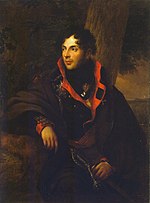Battle of Gotthard Pass
The next day, Suvorov's army fought its way north along the upper Reuss River valley past the Teufelsbrücke (Devil's Bridge) in Schöllenen Gorge.
The term summarises a total of five battles or engagements between Airolo and Altdorf fought against the retreating French troops over the course of three days.
Together with Austrian and Swiss forces led by Feldmarschall-Leutnant Friedrich Freiherr von Hotze, they would sweep General of Division André Masséna's French Army of Helvetia from Switzerland.
Once Korsakov was securely in position in central Switzerland, Feldzeugmeister Archduke Charles, Duke of Teschen would march his 60,000 troops north into Germany, leaving 18,000 Austrians under Hotze to cooperate with the Russians.
Charles would thrust across the lower Rhine from southern Germany into France while a second Austrian army under General der Kavallerie Michael von Melas would invade Savoy from Italy.
[2] After days of enforced idleness, Suvorov accepted Grand Duke Constantine's idea to dismount 1,500 of his Cossacks and use their horses as pack animals.
Derfelden's 8,591-man corps consisted of General-major Pyotr Bagration's Advance Guard (2,394), Lieutenant General Yakov Ivanovich Povalo-Schveikovsky's infantry division (4,360), and 1,837 Cossacks.
[19] Derfelden's corps left Bellinzona on 22 September amid heavy rains, after having started from Taverne the previous day.
By Duffy's reckoning, Gudin's brigade numbered 3,801 men and consisted of the 67th and 109th Line Infantry Demi-brigades and three grenadier companies.
His patrols detected Strauch's Austrians in the Ticino valley and from 20 September there were even reports of Russian soldiers nearby.
[26] In previous campaigns, Lecourbe proved himself a capable general in mountain fighting, but this time he found himself poorly prepared for Suvorov's impending attack.
[27] Suvorov's plan of attack for 24 September called for the main effort by Derfelden's Russians and Strauch's Austrians against the Gotthard Pass.
[26] The 67th Line with 1,861 soldiers was divided into three groupings, at Airolo, at the hamlet of Cima del Bosco near the entrance to the Val Tremola, and at the pass itself.
This hike might take an unencumbered person two and a half hours, but the Russians and Austrians would have to carry a musket, ammunition, battle gear, and full haversack with French firearms blazing in their faces.
Its assignment was to block the valley leading west to prevent any interference from French troops under General of Division Louis Marie Turreau.
The Austrians soon turned north to cross over the mountains and reach the Maderanertal, an alpine valley which led west to Amsteg.
A short distance north of Andermatt was the Schöllenen Gorge, a canyon so narrow that if the French had been present in sufficient strength, they might have held their ground indefinitely.
[33] At 9:00 pm on 24 September, unaware that the Gotthard had already fallen, Lecourbe wrote a letter to Masséna, "I have just heard that the enemy are attacking us at Airolo.
General-major Mansurov led the remainder of the Mansorov and Rehbinder Musketeers directly against the Urnerloch, chasing the French skirmishers through the tunnel.
That evening Korsakov found that his ally Hotze was dead and his force beaten in the Battle of Linth River by Jean-de-Dieu Soult's division.
Korsakov and his generals appear to have "lost their heads" when they decided to break out of Zürich the next day and make for Eglisau on the Rhine.
The battalion of the 76th Line that formed the French rearguard was unable to hold back the Allies who crossed the remnants of the Charstelenbach bridge at Amsteg.
Lecourbe worried that Suvorov's soldiers might break out of the upper Reuss valley to the west in an attempt to reach Lucerne.
[40] Since leaving Taverne, the Russian army had marched a distance of 80 miles (129 km) in five days across extremely difficult terrain.
A depot of flour found at Andermatt was used up by Rosenberg's corps within one day and the all food stored at Altdorf was eaten by two battalions.
[4] On 27 September, Suvorov's army began crossing the Kinzig Pass to Muotathal where Bagration's advance guard wiped out a company of the 38th Line.
[44] Rosenberg's corps stayed in the upper Reuss valley to protect the train of mules and Cossack horses that were carrying the supplies.
Rosenberg soon counterattacked with the Tyrtov and Mansurov Musketeers, evicting the French from the town and clearing them from the east bank of the Reuss.
On 28 September, Rosenberg's corps began crossing the Kinzig Pass in rain and snow while his rearguard under Förster held the Schächental behind him.
To his amazement the French replied that the Cossacks ought to surrender since Masséna had won a great victory and captured 20,000 Allied troops.








